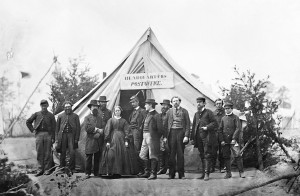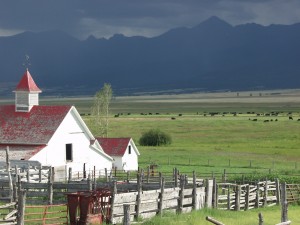By Ed Quillen
The American Civil War, whose sesquicentennial begins this month, started years before there was a place named Salida, and even its nearest battles were hundreds of miles away.
Even so, there’s a big stone memorial that faces F Street from Riverside Park behind a park bench. The letters are getting indistinct, but they remain legible if you get close: “Our Honored Heroes. 1861-1865. Erected by Salida Circle No. 12 Ladies of the Grand Army of the Republic Department of Colorado and Wyoming, A.D. 1916.”
Ponder that for a moment. It was put up 61 years after the Civil War ended, far from any historic battle site, in a town that didn’t even exist when the war was being fought. Yet the women’s auxiliary of a veterans’ organization raised money and put up the memorial. The Civil War was that big a deal, even as it pertains to our local history.
In a technical sense, the first shots of the Civil War were fired 150 years ago. The shooting began at 4:30 a.m. on April 12, 1861, with cannon fire aimed at a Union outpost, Fort Sumter. The fort sat on an island in the harbor of Charleston, South Carolina – which had been the first state to secede, back on Dec. 20, 1860.
The fort was bombarded for 34 straight hours before the Union commander, Maj. Robert Anderson, hauled down the American flag and surrendered to overwhelming force.
The conflict between north and south had been going on for a long time before that, of course, dating back at least to the compromises involved in agreeing on the federal constitution of 1787.
Most of the struggle had been political, waged in the halls of Congress. Even there it became physical on occasion, as in 1856 when Massachusetts Sen. Charles Sumner was severely beaten with a cane by Rep. Preston Brooks of South Carolina.
Considerable blood was shed from 1854 to 1858 in “Bleeding Kansas.” Both free-soilers and slavery advocates rushed into the territory, each side hoping to control the territory’s future. There was abolitionist John Brown, later of Harper’s Ferry fame, leading his sons to hack slave owners to death with broadswords. Anti-slavery men were killed by “border ruffians” coming in from Missouri who wanted to bring plantation agriculture to Kansas.
They were fighting over the future of Kansas. And at the time, the site of Salida was in Kansas, along with much of the rest of Central Colorado. Kansas Territory then had the same boundaries as the state does today, except much of it extended west to the Great Divide.
Salida, Buena Vista, Saguache, Fairplay and Leadville sat in Fremont County, Kansas. Cañon City and Pueblo were in Broderick County. Denver was in Montana County, Kansas Territory. There was a “New Mexico notch” then that put the southern San Luis Valley, as well as much land to the east, in Taos and Mora counties of New Mexico Territory, and west of the Divide was Utah.
So this area, even though it was relatively unpopulated then, was not isolated from the struggles that led to the Civil War. And the big struggle wasn’t just about Kansas, it was about what sort of place the West would become. You could make the argument that the bloodiest war in American history was fought about us, or at least the place we live – would it be large plantations tilled by slaves, or the small family farms of freeholders?
How to make that argument? It would take a book or two to provide sufficient detail, but let’s look at the big picture. Thanks to the division between free-labor North and slave-labor South, the United States had a lot of trouble swallowing new territory.
East of the Mississippi, on land ceded by Great Britain in 1783 after the Revolutionary War, the process was fairly simple. Congress banned slavery in the “Old Northwest” – Ohio, Michigan, Illinois, Minnesota, Indiana, Wisconsin, etc. – and allowed it in the “Old Southwest” of Alabama, Mississippi, Tennessee, etc. As those territories became states, they preserved their labor systems.
Then came the Louisiana Purchase of 1803. What part should be slave and what part free? Congress eventually cobbled together the Missouri Compromise of 1820, which banned slavery north of 36°30”, except in Missouri. (That line persists on the map today as the north border of Texas, just below the Oklahoma panhandle.)
In order to preserve slavery which had been outlawed by Mexico in 1829, Texas seceded from that country in 1836, operated as an independent republic (one that claimed but never organized our part of the world) for a few years, and joined the United States in 1844. That touched off the Mexican War of 1846-48, and meanwhile the U.S. negotiated a settlement with Great Britain over the “Oregon Territory.”
After the treaties were signed and the United States extended to the Pacific Ocean, our country had to figure out how to organize the new territory. It should be noted that slavery cannot exist without a legal system to support it – to catch runaways, etc.
Initially, the solution appeared to be to extend the Missouri Compromise line to the Pacific: Slaves to the south, free labor to the north. But Southerners made a logical argument (even if it doesn’t strike us today as a particularly moral argument): If a settler could bring his horses and oxen and plows and like property to a territory, why couldn’t he bring another species of property, his slaves, no matter whether the land was north or south of the Missouri Compromise line?
Henry Clay, the brilliant congressman from Kentucky, cobbled together the Compromise of 1850, whose details would just derail us here since the arguments continued. Illinois Sen. Stephen A. Douglas proposed “popular sovereignty” as the solution when he introduced a bill organizing Kansas and Nebraska territories. The settlers, rather than Congress, could make the decision.
Sounds fair and democratic – unless you’re a slave, of course – but it led to “Bleeding Kansas” as both sides rushed in with men and arms. And it also led to the founding of the Republican Party, which organized in opposition to the Kansas and Nebraska acts. And then there was the 1857 Dred Scott decision, in which the U.S. Supreme Court ruled that Congress had no power to prohibit slavery in the territories.
Now let us ponder the first Republican president, Abraham Lincoln. By all accounts, Lincoln personally detested slavery, but he took pains to point out that he was no abolitionist. He was willing to let slavery abide where it existed, and to enforce the Fugitive Slave Act. But he was steadfast on one position: No expansion of slavery to the territories – that is, our part of the world.
The South feared for its future after Lincoln was elected. If the territories had free labor and became states, they would outnumber the South in Congress, and its “peculiar institution” would be threatened by that tyrannical over-reaching federal government they still complain about. Modern Confederate apologists come up with all sorts of theories about tariffs and states rights – but the simple fact is, the South seceded to protect slavery. You can read that today in their declarations of secession.
Although Lincoln never visited the West, he was deeply concerned with holding it in the Union. He didn’t enforce the unpopular draft in the territories. Perhaps on that account, Colorado stayed Unionist despite most of its early gold discoveries being made by Georgians, who soon felt unwelcome and generally left the territory.
Lincoln pushed the Transcontinental Railroad to connect the territories to the Union in good time, and in the interim, his federal government improved communications (the 1861 telegraph line to the West Coast) and transportation (after a Confederate sea raider nearly captured a ship carrying California gold, it was all hauled overland).
The Republicans in Congress passed the Homestead Act – previously blocked by Southerners who had by then left Washington – to make the territories a land of small free-holders rather than large land barons (didn’t always work, but their hearts were in the right place).
The Homestead Act, which let you claim land if you’d work it, was a model for the General Mining Act of 1872, which allowed you to claim mineral deposits if you’d work them, and the 1876 Colorado Doctrine of Prior Appropriation, which allowed you to claim rights to the water you could put to “beneficial use.”
So even if the nearest Civil War battle was at Glorieta Pass east of Santa Fe on March 26-28, 1862, the Civil War shaped our part of the world. It determined our political boundaries, our land-use patterns, our transportation and communication connections, our industries, our water allocation, even our educational systems (land-grant colleges were part of the Republican Civil War legislation).
Thus we can rightfully join the rest of America in commemorating its 150th anniversary. Even out here in the territories, far from Vicksburg and Gettysburg and Appomattox, far from chattel slavery, it was a big deal, maybe the biggest deal in American history, and our territory was part of the deal.
Ed Quillen of Salida is a practicing history buff and railroad buff, neither of which he practices in the buff.


